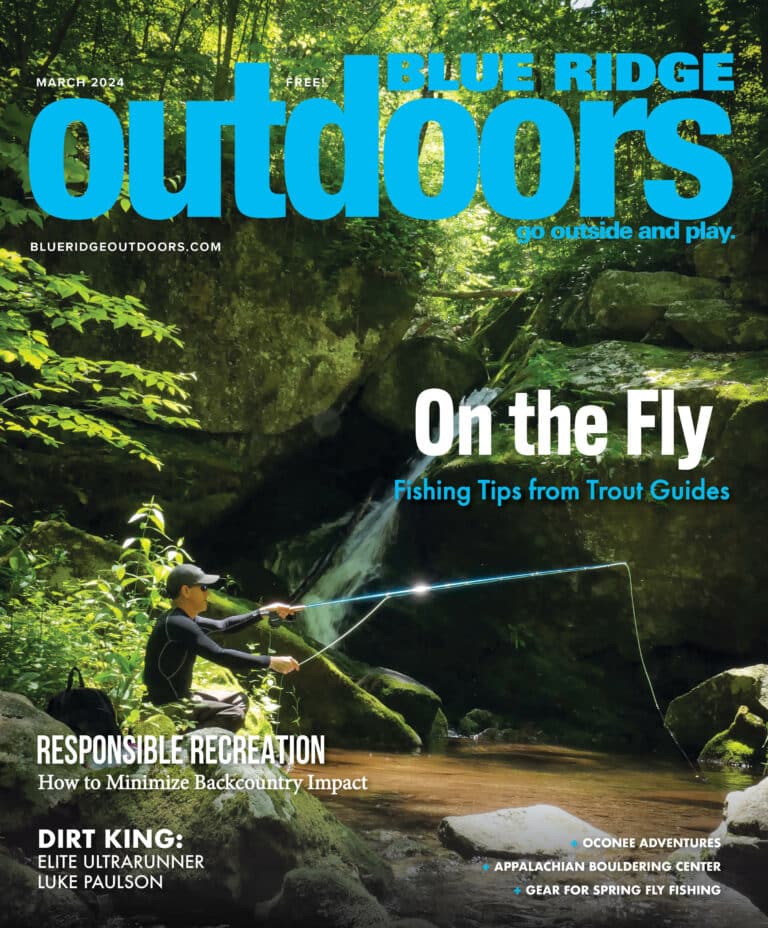Stunning views and rock scrambling makes for a classic day hike in Virginia’s Shenandoah National Park
There’s something thrilling about summiting a mountain. This feeling was palpable among the 20 other hikers heading uphill from the Old Rag parking lot. The Ridge Trail wasn’t too crowded, but almost everyone seemed to be sprinting out of the gate, trying to get in front.
“Let’s pace ourselves,” I suggested to my wife. “We’ll probably just pass them all later.”
We stepped off the trail to let a group of laughing college kids practically run past. There was no need to hurry. It was 9 a.m. on a foggy Thursday morning in early August, with temps in the mid-60s. We had plenty of time to complete the 9.4-mile loop, which starts with an elevation gain of 2,348 feet when heading in the suggested clockwise direction.
I’d heard good things about this challenging summit hike, which is the most popular trail in Shenandoah National Park. Many of the park’s 1.5 million annual visitors come from the Washington, D.C. metro area, located about 90 miles east. In recent years, Old Rag had developed a reputation for overcrowding, particularly during summer and fall weekends. At times, lines of hikers might form below the trickier spots.
Then in 2022, the park service followed a growing trend at popular outdoor sites. They instituted a daily quota system, capping Old Rag users at 800 per day. The $2 tickets are released on Recreation.gov, with half available 30 days in advance and the rest available five days ahead. Two weeks before, I’d targeted our hike for a weekday, not knowing what to expect. When we checked in at the entrance station, the ranger said only about 350 spots had been reserved that day.

From Forest to Granite
For a mile, the trail rose gradually through an impressive hardwood forest before steepening with a series of rocky switchbacks. As predicted, we slowly passed most of the groups who had rushed ahead at the beginning. Some folks were resting on rocks. Others kept glancing nervously uphill. A few people turned around and went back down.
As we ascended, deciduous trees gave way to an increasing number of conifers. A steady mist blew eerily through the treetops. After about 2.5 miles, we emerged on a sparsely vegetated ridgeline and began traversing granite slabs and ledges. The fog had lifted by now, and occasional viewpoints revealed a string of colorful specks. These were people slowly making their way toward the summit. To either side were wide open views of the shadowy peaks and ridges of the Appalachians.
The repeated exclamations of nearby hikers made it clear why this is such a beloved route. By now, we’d made friends with a few groups moving at roughly the same pace. Occasionally, we took breaks together and chatted about our impressions of the park.

An “Eastern Park in the Western Tradition”
Both Shenandoah and Great Smoky Mountains National Parks were authorized in 1926. The goal was to create two Western-style national parks—like Yellowstone and Yosemite—in the Southern Appalachians. However, obtaining the needed lands in these more populated regions was much harder than reappropriating federal lands in the West. Numerous private parcels had to be acquired in Virginia, North Carolina, and Tennessee through purchases, donations, and controversial declarations of eminent domain. The process was still underway in the early 1930s when a third unit, the Blue Ridge Parkway, was authorized to connect the two national parks.
Summiting Old Rag was the main goal for our first visit to Shenandoah. Yesterday, we’d put our camper at the wooded Big Meadows Campground. At just over 3,500 feet, this popular area often has a steady breeze and mild temps compared to the valleys below. After setting up, we walked over to the visitor center and did a short hike to Dark Hollow Falls. Camping at Big Meadows put us in the heart of the park, about an hour from Old Rag. It’s important to note that the trailhead is located on the eastern edge of the park, so you have to drive out and around through Sperryville.
Aside from Old Rag, Shenandoah’s primary feature is the 105-mile Skyline Drive. Like the parkway, it follows the crest of the Blue Ridge Mountains. Along the way, there are lookouts, campgrounds, lodges, waterfalls, hiking trails, and over 90 named peaks. Among those peaks, many are capped with greenstone, a type of metamorphic volcanic rock. This includes the park’s highest point, Hawksbill Summit at 4,050 feet, which can be reached by several short but steep trails just off Skyline Drive. Despite being on the shorter side, Old Rag is unique for its granite bedrock and massive boulders that hikers increasingly encounter as they approach the 3,284-foot summit.

Rock Scramble to the Summit
The best part of hiking Old Rag began about a mile below the summit, around 2,200 feet. That’s where the trickier rock scrambling started. At first, this mostly involved mounting rounded boulders using hands and feet. My wife was doing well but getting wary about what was to come. Glancing ahead, we could see the terrain steepened.
“This is tough,” she said, wiping away sweat during a break.
One reason for her nervousness was due to our prior encounter with a “big talker.” Three months before, we were chatting with a hiker on a waterfall trail in the Smokies. When he heard we were heading to Old Rag, he turned serious.
“That’s a dangerous hike,” he said. “You’re basically rock climbing without a rope.”
The way he went on to describe ascending Old Rag, like it was comparable to free soloing El Capitan, did not sound accurate. But his warning had clearly rattled my wife.
“Maybe I should skip that one,” she said, the moment he was gone.
I disagreed. The guy was clearly talking himself up by over-selling the difficulty of Old Rag. Yes, we needed to be cautious, but the route was a scramble, not a big wall climb. Still, he’d sowed enough doubts for me to toss in my backpack a short rope that never got used.

After a quick rest, my wife and I reached our first real “move” on Old Rag. A sunken crevice about eight feet deep. There were several ways to descend, and it reminded me of exploring slot canyons out West. Our technique involved scooting forward into the gap and lowering ourselves using legs, arms, and bodies to wedge against the walls. Once our feet rested on a narrow ledge, we crept carefully to the end.
Not everyone was as experienced, and two college girls behind us seemed overwhelmed and about to give up. My wife slipped into teacher mode. She scrambled back up the slot and demonstrated the technique. The first girl taught her friend, and gradually all three emerged, brimming with confidence.
From here, we skirted along some cliffs. Clambered over rocks and up bare slopes. Occasionally, the route followed cracks or passed under small alcoves. Sometimes we hand-walked. A few times we crab-walked. One intriguing feature was a natural staircase rising up through another narrow crevice. We spent an hour on the rock scramble, stopping often to wait for others, pace ourselves, and enjoy the views.

A Classic National Park Hike
By noon we were on top, having lunch while sitting on smooth boulders. Nearby were a dozen other hikers, each of them clearly tired but buzzing with excitement. Always a good sign.
Granite is my favorite type of rock, and it reminds me of a favorite mountain range, the Sierra Nevada in California. I’ve been atop numerous peaks there, including Half Dome in Yosemite. Hiking that 8,846-foot peak is definitely tougher than Old Rag, involving almost twice the mileage and elevation gain, and ending with a careful scramble up the smooth dome assisted by cables.
Meanwhile, across the Appalachians, some of the highest peaks have been developed, with nearby parking lots allowing easy access to short, graded paths leading to observation platforms. That does make the summits more accessible to everyone, but it also can dampen the thrill for many outdoor folks.
In contrast, Old Rag offers a little bit of everything adventurers seek from a summit hike: a physical challenge, a rugged landscape, and plenty of scenic rewards.
We might have stayed longer, but thickening clouds were rolling in. Light rains caught us several times on the more gradual descent, which starts with about 1.5 miles on the Saddle Trail and ends with three miles on a fire road. As we neared the bottom, we were exhausted, in a good way.
“I think that’s one of the hardest hikes I’ve done,” said my wife.
“That is a classic national park hike,” I mused.
Like a small piece of Yosemite inside Shenandoah National Park.








